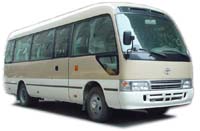 The Forbidden City
(the Imperial Palace or Gugong), more correctly known today as the Palace Museum,
is the most magnificent imperial palace complex in China and is
located in the heart of the city across from Tian'anmen Square. The
Palace complex lay at the heart of the original Ming Dynasty plan
for Beijing devised by the Yong Le emperor in the fifteenth century,
and is still regarded as the central point of the modern capital. In
1987, the Forbidden City was added to the list of UNESCO World
Cultural Heritage sites. The Forbidden City
(the Imperial Palace or Gugong), more correctly known today as the Palace Museum,
is the most magnificent imperial palace complex in China and is
located in the heart of the city across from Tian'anmen Square. The
Palace complex lay at the heart of the original Ming Dynasty plan
for Beijing devised by the Yong Le emperor in the fifteenth century,
and is still regarded as the central point of the modern capital. In
1987, the Forbidden City was added to the list of UNESCO World
Cultural Heritage sites.
The Palace was constructed during the Ming Dynasty
construction spanned over 14 years from 1406 to 1420.
Historical records show that it took at least one million workers
and 10,000 artisans to build it, using building materials from many
parts of China. Heavy items that had to be transported over long
distances usually meant creative ways of transportation were
invented. For example, wells were dug to pour water on the roads to
coat them with ice in the wintertime, making it easier to transport
stones.
The Palace served as the residence of 24 Ming and Qing dynasty
emperors, and was the political center of gravity of the
entire Chinese empire, housing a vast and privileged retinue of
officials, advisors, generals, concubines and eunuchs. The Palace
attracted vast riches over the centuries in the form of tribute, and
its artistic collections were swelled by thousands of items made in
the Palace workshops themselves or purchased for use by the imperial
household. In 1912, the imperial era came to an end when the emperor
Pu Yi abdicated, but he was permitted to continue living in the
northern part of the Forbidden City complex. It was not until 1924
that he was finally expelled from the home of his ancestors. The
next year, the Forbidden City was established as the Palace Museum.
The
Forbidden City is divided into two parts, the southern section of
the Outer Court, which was where the emperor exercised his power,
and the northern section or the Inner Court, which served as the
residence for him and the imperial family. Both courts account for
an area of 163,000sqm. These areas were designed according to the
architectural hierarchical code to reflect the status and power of
the emperor. The court was limited to royal members and the emperor;
common people would be prohibited from entering or coming within
close proximity of the area. Today, some of the halls have been
converted into galleries that exhibit ancient paintings,
calligraphy, clocks, bronze wares, pottery and other valuable
treasures used by the court. It is estimated that at least 1.5
million articles are protected by the museum.
Visitors going to the Forbidden City go to see how royalty lived
during the empire, but also go to experience four of its major
attractions: the
Meridian Gate (Wu Men,), Hall of Supreme Harmony (Taihe Dian), Hall
of Heavenly Purity (Qingqing Gong,) and Hall of Mental Cultivation (Yangxin
Dian,).
Entering the Forbidden City was a ritual of its own. The rules
stated that the central arch was exclusively reserved for the
emperor. Empresses were granted a one-march ticket; usually, her
wedding day. Other days, she had to abide by a strict code of
conduct. Other marchers would include the three finalists of the
national examination, which was presided over by the emperor. They
would be allowed to march through the archway following interviews
with the emperor. Ministers used the smaller arch to the east while
the royal family used the arch to the west. Officials and eunuchs
used the remaining arches.
It
is believed that the emperor is a reincarnation of the dragon and
thus, the hall's interior is symbolically paved with golden bricks
and the color yellow dominates the thrones, columns, windows and
ceilings. The throne sits on a platform in the north of the hall,
with an elegant wall screen behind, and three gilded columns on each
side. There are mythical beasts, cranes, and incense burners laid in
front of the throne. The ceiling is adorned with a dragon with a
pearl in its mouth.
The
Forbidden City is a huge complex, and a visit can be an exhausting
experience. If you are in Beijing for a while, consider making
several visits rather than seeing everything in a single day.
Remember too that it is a Museum, with a lively program of standing
and temporary exhibitions; it is worth checking the Palace Museum
website for information on displays before visiting.
Check our Beijing Bus Tour Programs
for Forbidden City Tours. You can tour Beijing with our
group bus tour programs for various routes.
Learn more about Beijing private and
non-private tours.

|

